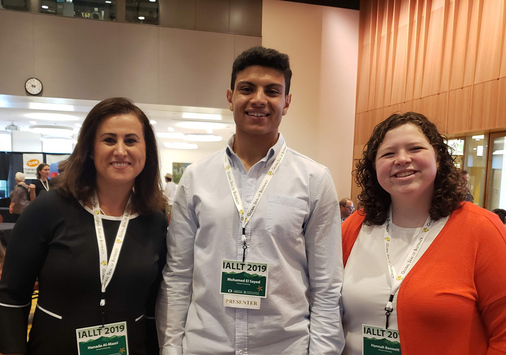Faculty Research Interests
Our faculty members are active scholars in a wide variety of chemical and biochemical disciplines, regularly presenting their work at professional conferences and publishing their findings in peer-reviewed scientific journals. The department is deeply committed to sustaining a vigorous and diverse range of collaborative student-faculty research, and the majority of our majors engage in a meaningful research experience prior to graduation.
Next-Gen. Semiconductors, Nanomaterials, Renewable Energy, Optoelectronic Devices, Excited State Processes & Energy Flow, Defect/Active Site Control, Optical Spectroscopy, Microspectroscopy, Picosecond Spectroscopy, Photon Correlations
A physical chemist with a background in the optical spectroscopy and electronic properties of organic and low dimensional semiconductors. The Atallah lab focuses on uncovering and controlling the unconventional properties of doped organic crystalline, colloidal inorganic nanocrystalline, and hybrid-organic inorganic 1D and 2D semiconductors for applications in light emitting diodes (LEDs), solar cells, sensors and transistors.
Physical Chemistry
She studies the diffusion of water in mixed-phase thin films to better understand water movement in complex mixtures such as those found in atmospheric secondary organic aerosols and hydrophobic coatings in nature.
Organometallic Chemistry
Synthesis and characterization of methylene-bridge-substituted calixarenes. These molecules provide access to new structural motifs in calixarene chemistry. A methylene-bridge substituent allows for modification of the solubility, conformational rigidity, and conformational preferences of a calixarene in comparison to the unsubstituted species.
solar energy; renewable energy; photoelectrochemistry, nanomaterials, spectroscopy; electrochemistry
A materials and physical chemist, I work on synthesis and characterization of semiconducting nanomaterials for use in solar cells that produce clean and renewable fuels. Combined with low-cost synthetic methods that rely on self-assembly to make nanostructures, I use electrochemical and spectroscopic methods to probe and better understand interfacial electron-transfer reactions in working solar cells.
Biochemistry
Peter Kuhlman, a biochemist, has an overarching interest in molecular evolution, currently exploring the biomolecular means by which the social amoeba Dictyostelium discoideum “farms” bacteria.
Biochemistry
Rachel Mitton-Fry, a biochemist, is interested in structure-function relationships in non-coding RNA elements. Current work in the Mitton-Fry laboratory focuses on RNA thermosensors, RNA elements that affect gene expression levels in response to temperature variation.
Synthetic Organic/Materials Chemistry
Interested in developing new organic materials, potentially for use in molecular electronics, and specifically for use in low-cost solar cells. His research integrates organic synthesis and characterization of self-assembling liquid crystalline materials along with the actual fabrication and testing of devices.
Chemical Biology
Chemistry of biological surfaces, particularly those that contain sugars, and the role of the sugars at these surfaces. Research in the group includes synthesis of a glycosylated silicate-polymer as a model surface for probing carbohydrate interactions, and the cloning, expression and characterization of penicillin-binding proteins from Bukholderia cenocepacia to study their interactions with antibiotics.
Laurie Waters, a biochemist, studies how bacteria sense, respond, and adapt to environmental changes at the molecular level. She is interested in the regulation of gene expression and protein activity during bacterial stress responses. Current work in the Waters laboratory focuses on the role of small proteins and regulatory RNAs in metal ion homeostasis in E. coli.
Cassie Zaremba, an organic chemist, has an interest in the diverted synthesis and structure-activity-relationships of natural products that exhibit antimicrobial activities, specifically antibacterial and antifungal properties.













